| Oracle® Application Express Application Migration Guide Release 3.2 Part Number E12509-01 |
|
|
PDF · Mobi · ePub |
| Oracle® Application Express Application Migration Guide Release 3.2 Part Number E12509-01 |
|
|
PDF · Mobi · ePub |
This section describes the steps to migrate applications from Microsoft Access to Oracle Application Express.
This section contains the following topics:
Read "Preparation Checklist for Migrating Microsoft Access Applications".
To migrate applications from Microsoft Access to Oracle Application Express, you must perform the steps described in this section. This graphic outlines the entire process:
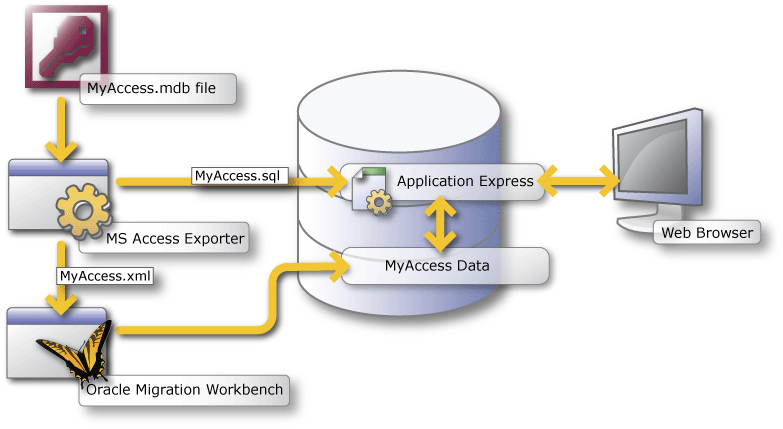
The migration process consists of the following steps:
Step 1: Export Microsoft Access Metadata
Step 2: Migrate the Microsoft Access Database to Oracle
Step 3: Create a Workspace and Add Oracle Application Express Users
Step 4: Create a Migration Project
Step 5: Review Your Retrieved Objects
Step 6: Generate the Oracle Application Express Application
Important:
You must follow the steps in the exact sequence presented in this section.To export your metadata from Microsoft Access, download the correct version of the Exporter tool, as explained in this section. Then, run the Exporter and extract the metadata from the Microsoft Access .mdb file. The metadata contains the necessary database and application schema information.
The export process creates two output files:
database (.xml file)
application (.sql file)
Note:
Follow the instructions in this section if you are downloading the Exporter tool from Oracle Application Express release 3.0 or later. Alternately, you skip the following task and access the Exporter directly from Oracle SQL Developer using the Migration menu.To download the Exporter tool for Microsoft Access:
Log in to Oracle Application Express 3.0.
Under Migrations on the right side of the Workspace home page, click Application Migrations.
Under Tasks on the right side of the page, click Download Exporter for Microsoft Access.
In the Download column, click the zip file that corresponds to your version of Microsoft Access. For example, download the omwb2003.zip file if you are using Microsoft Access 2003.
Save the file.
Unzip the file. You must replace the following files with the updated versions in the msaccess_exporter directory where you unzipped Oracle Migration Workbench:
schema.dtd file
Exporter tool file: omwb<version>.mde
online help file: omwb.chm
Be sure to invoke the export from this directory.
To export your metadata, follow the instructions found in the help file for the Exporter tool. To find the instructions, do one of the following:
Launch the Exporter tool, and click the Help button.
Open the help file (omwb.chm) contained in the Exporter zip file.
The instructions appear in the topic called Exporter Overview.
To migrate the Microsoft Access database to Oracle:
Start Oracle SQL Developer version 1.2.0 or later. For example:
Create an Oracle user named MIGRATIONS with the default tablespace USER and temporary tablespace TEMP and grant it at least RESOURCE, CREATE SESSION, and CREATE VIEW privileges.
Create a database connection named Migration_Repository that connects to the MIGRATIONS user.
Right-click the connection, select Migration_Repository, and then select Migration Repository and then Associate Migration Repository to create the repository.
Load the database metadata (.xml file) created in step 1. Select Migration and then Capture Microsoft Access Exported XML.
This captures the schema and creates a Captured Model of the Microsoft Access database.
Convert the captured database schema to Oracle. Right-click Captured Model and select Convert to Oracle Model.
Generate the migrated Oracle database schema. Right-click Converted Model and select Generate.
The generated DDL statements should execute against your Oracle database instance, to generate the migrated schema objects.
For more information about Oracle SQL Developer Migration Workbench, see:
http://www.oracle.com/technology/tech/migration//workbench/index_sqldev_omwb.html
When using Oracle SQL Developer Migration Workbench, you must verify that the generated DDL statements are executed against the same instance where Oracle Application Express 3.0 or later is installed. If you select a Least Privilege Schema Migration, the migrated objects can be created in an existing schema on your database instance. Otherwise, a schema of the same name as the captured database (for example, Northwind) is created on your database instance.The migrated Oracle database schema objects must be in the same instance where Oracle Application Express 3.0 is installed. If they are not, you will not be able to complete the next step.
A workspace is a virtual private database allowing multiple users to work within the same Oracle Application Express installation while keeping their objects, data and applications private. Each workspace has a unique ID and name.
An Oracle Application Express administrator can create a workspace manually within Oracle Application Express Administration Services or have users submit requests. Oracle Application Express Administration Services is a separate application for managing an entire Oracle Application Express instance. See "Creating Workspaces" and "Managing Workspace Requests" in Oracle Application Express Administration Guide.
See Also:
Oracle Database 2 Day + Application Express Developer's Guide if you are new to Oracle Application ExpressTopics in this section include:
To create an Oracle Application Express workspace manually:
Log in to Oracle Application Express Administration Services. Oracle Application Express Administration Services is a separate application for managing an entire Oracle Application Express instance. You log in using the ADMIN account and password created or reset during the installation process.
In a Web browser, navigate to the Oracle Application Express Administration Services application. By default, Oracle Application Express Administration Services installs to the following location:
If your setup uses the embedded PL/SQL gateway, go to:
http://hostname:port/apex/apex_admin
Where:
hostname is the name of the system where Oracle XML DB HTTP Server is installed.
port is the port number assigned to Oracle XML DB HTTP Server. In a default installation, this number is 8080.
apex is the database access descriptor (DAD) defined in the configuration file.
If your setup uses Apache and mod_plsql, go to:
http://hostname:port/pls/apex/apex_admin
Where:
hostname is the name of the system where Oracle HTTP Server is installed.
port is the port number assigned to Oracle HTTP Server. In a default installation, this number is 7777.
pls is the indicator to use the mod_plsql cartridge.
apex is the database access descriptor (DAD) defined in the mod_plsql configuration file.
On the Login page:
In Username, enter admin.
In Password, enter the Oracle Application Express administrator account password you specified when you installed Oracle Application Express.
Click Login.
See Also:
See "Logging in to Oracle Application Express Administration Services" in Oracle Application Express Administration Guide.Next, create a workspace.
Click Manage Workspaces.
Under Manage Workspaces, click Create Workspace.
The Create Workspace Wizard appears.
For Identify Workspace, enter a workspace name and description and click Next.
For Identify Schema, select the Oracle Forms application schema.
For Re-use existing schema, select Yes.
Select a schema from the list.
Click Next.
For Identify Administrator, enter the Workspace administrator information and click Next.
Confirm your selections and click Create.
To create an Oracle Application Express user account:
Log in to Oracle Application Express Administration Services. See "Logging in to Oracle Application Express Administration Services" in Oracle Application Express Administration Guide.
Click Manage Workspaces.
Under Manage Workspaces, click Manage Developers and Users.
The Manage Developers and Users page appears.
Click Create.
The Create/Edit User page appears.
Under User Attributes, enter the appropriate information. Fields marked with an asterisk are required.
Tip:
To learn more about a specific attribute, click the item label. When Help is available, the item label changes to red when you pass your cursor over it and the cursor changes to an arrow and question mark.Under Password, type a case-sensitive password for this account.
If your organization has set up a password policy, be sure the password meets the requirements.
Under Developer Privileges, select the appropriate privileges:
User is a developer - To add this user as a developer, select Yes. For end users, select No.
Developers can create and modify applications and database objects as well as view developer activity, session state, workspace activity, application, and schema reports.
User is a workspace administrator - To add this user as a Workspace administrator, select Yes. For developers or end users, select No.
In addition to having developer privileges, workspace administrators can create and edit user accounts, manage groups, alter passwords of users within the same workspace, and manage development services.
Under Account Control, specify the following:
Account Availability - Select Unlocked to enable a user to log in to this account.
Require Change of Password on First Use - Select Yes to require the user to change the password immediately after logging in with the current, temporary password. Otherwise, select No.
Click Create User or Create and Create Another.
Once you create a workspace, you must log in to it using your login credentials (that is, the workspace name, user name, and password).
See Also:
See "Creating Workspaces" and "Managing Workspace Requests" in Oracle Application Express Administration GuideTo log in to a workspace:
In a Web browser, navigate to the Oracle Application Express Login page. By default, Oracle Application Express installs to the following location:
If your setup uses the embedded PL/SQL gateway, go to:
http://hostname:port/apex
Where:
hostname is the name of the system where Oracle XML DB HTTP Server is installed.
port is the port number assigned to Oracle XML DB HTTP Server. In a default installation, this number is 8080.
apex is the database access descriptor (DAD) defined in the configuration file.
For users who have upgraded from earlier releases, or who have a custom configuration, this value may be htmldb or something else. Verify your DAD with your Oracle Application Express administrator.
If your setup uses Oracle HTTP Server (Apache) and mod_plsql, go to:
http://hostname:port/pls/apex
Where:
hostname is the name of the system where Oracle HTTP Server is installed.
port is the port number assigned to Oracle HTTP Server. In a default installation, this number is 7777. You can find information about your Oracle HTTP Server installation's port number from either of the following files:
ORACLE_BASE\ORACLE_HOME\install\portlist.ini ORACLE_BASE\ORACLE_HTTPSERVER_HOME\Apache\Apache\conf\httpd.conf
Be aware that if you change a port number, it is not updated in the portlist.ini file. You can only rely on this file immediately after installation.
pls is the indicator to use the mod_plsql cartridge.
apex is the database access descriptor (DAD) defined in the mod_plsql configuration file.
For users who have upgraded from earlier releases, or who have a custom configuration, this value may be htmldb or something else. Verify your DAD with your Oracle Application Express administrator.
The Login page appears.
Under Login, enter the following:
In the Workspace field, enter the name of your workspace.
In the Username field, enter your user name.
In the Password field, enter your case-sensitive password.
Click Login.
Note that, depending on your setup, you might be required to change your password when you log in for the first time.
To create a migration project:
Log in to Oracle Application Express.
Make sure you log in to the workspace you created for your migration project (Step 3).
Under Migrations on the right side of the Workspace home page, click the Application Migrations link.
On the Application Migrations page, click Create Project.
The Create Migration Project wizard appears. Note that the steps included in the wizard appear in a flowchart on the left of the page.
Enter the project details:
Project Name - Enter a unique name. You might want to use the same name as the Microsoft Access .mdb file you used to create the project.
Type - Select Access.
Description - Enter a meaningful description for this project. You might want to describe the Microsoft Access .mdb file that you used to create the project.
Migration Export File - Click Browse and select the .sql file created by the Exporter tool for Microsoft Access.
Schema - Select the schema.
The default schema is the schema associated with your workspace. If multiple schemas are associated with your workspace, all associated schemas appear in the select list, arranged in alphabetical order. When this situation exists, select the schema associated with the SQL script you want to upload.
Click Next.
Review the project details, and click Finish.
The project page appears.
See Also:
"About the Project Page", "Step 5: Review Your Retrieved Objects", and "How to Migrate a Microsoft Access Application"The project page initially shows a high-level overview of the Microsoft Access objects retrieved from your Microsoft Access database.
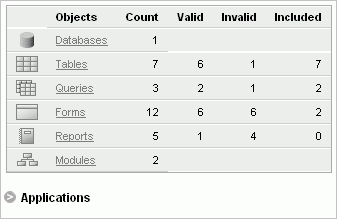
Specifically, the project page shows the status of these objects in your database:
tables
queries (now oracle views)
forms
reports
Additionally, for reference purposes only, the project page shows:
databases
modules
pages
Note that your project might not include all object types. The project page lists only object types that exist in your database.
After you generate applications from this migration project, an application list is created on the project page. To review the list, click Applications. This opens the list box where you can review application information or run an application.

Next, you want to select the objects to include in the migration. The initial list consists of the Microsoft Access application metadata that is retrieved, both valid and invalid.
To include an object, it must have a status of Valid. By default, all objects with a Valid status are selected. From within Application Migration, you can fix objects identified as invalid so that they can be included. Since the Application Migration also identifies tables without primary keys and objects without user interface defaults, you can correct those situations to maximize application design recovery.
Tip:
Extensive Oracle documentation is available for broadening your knowledge of database concepts and objects. For example, to learn more about primary keys and constraints, see Oracle Database Concepts or Oracle Database Application Developer's Guide - Fundamentals, which you can download from:Topics in this section include:
Next, review the Oracle tables retrieved from the Microsoft Access database. Application Migration identifies invalid tables without primary keys as well as those without user interface defaults, which you can add before migrating.
After you update the tables, select the ones you want to include in the migration. If you do not include a table, all forms and reports based on the table are excluded from the migration.
To review retrieved tables:
From the project page, click Tables.
The Tables page appears, showing the status of the objects ready for migration.
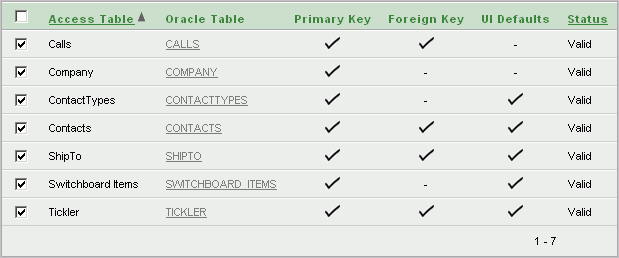
For each Microsoft Access table, the Tables page shows:
Oracle Table - The corresponding Oracle table, which defaults to the Microsoft Access table name in all capital letters.
Note that the name might also differ from the original one because of the collision management facility in Oracle Migration Workbench. For information about naming guidelines and restrictions, click Help in Oracle Migration Workbench and go to the Frequently Asked Questions section.
If the Microsoft Access object was not successfully migrated to Oracle, then this field will not have a corresponding Oracle table name. Instead, it will contain a link to a page where you can create a corresponding Oracle table.
Primary Key - Indicates if a primary key exists for the table.
A table without a primary key is considered invalid in Application Migration. You can create a primary key at this point. All tables you want to migrate should have a primary key.
Foreign Key - Indicates if a foreign key exists for the table.
If you know a relationship exists between two tables, you should create a foreign key. You can do this in Object Browser by creating a Foreign Key Constraint. For more information, see Table 16-1 in "Browsing a Table" Oracle Application Express Application Builder User's Guide.
UI Defaults - Indicates if user interface defaults are set for the table.
User interface defaults are used by Oracle Application Express to populate initial values for region and item properties. Using user interface defaults provides consistency across multiple applications or across multiple pages in an application.
Status - Table status as either Valid or Invalid.
Only valid tables can be included in the migration.
To create a table:
On the Tables page, click the link in the Oracle Table column for the table you want to create.
The Object Browser opens.
Click the Create button.
From the list of object types, select Table.
Follow the on-screen instructions.
To add a primary key:
On the Tables page, click the Oracle table name.
In the Tasks list on the right, click Create Primary Key.
For Constraint Details, fill in the information.
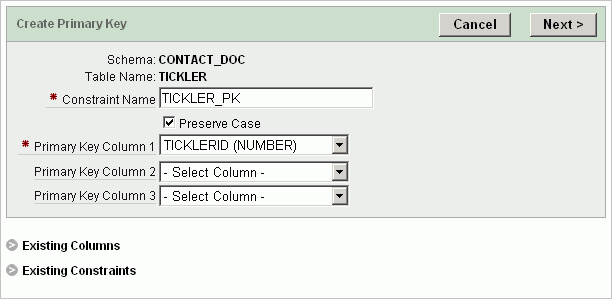
Tip:
To review the list of existing columns or constraints, click the Existing Columns or Existing Constraints links.Click Next.
Confirm the information and click Finish.
To add an index:
On the Tables page, click the Oracle table name.
In the Tasks list on the right, click Create Index.
Select the type of index you want to create on this table.
For indexing NUMBER, VARCHAR, and DATE, select Normal. For indexing CLOB columns, select Text.

Click Next.
For Index Definition, fill in the information.
The following graphic shows the fields to fill out if you selected Normal as the type of index.
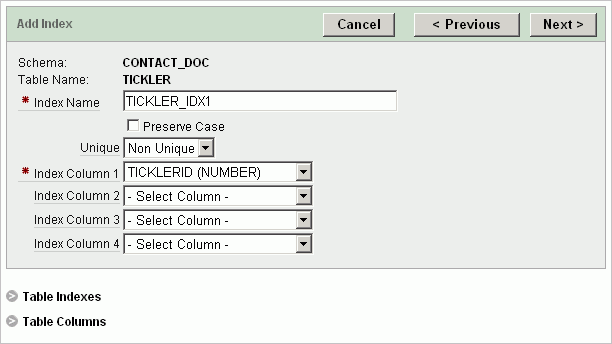
Tip:
To review the list of existing table indexes or columns, click the Table Indexes or Table Columns links.Click Next.
Confirm the information and click Finish.
To set user interface defaults:
On the Tables page, click the Oracle table name.
In the Tasks list on the right, click UI Defaults.
On the UI Defaults page, click Create Defaults.
The Table Defaults page appears, listing column information as it will appear in forms and reports. Note that you are now working within Application Builder, the component of Oracle Application Express where you can build and modify your applications.
To edit the information, click Grid Edit. You can update the column label, change the sequence the columns will appear by default, and so on.
Click Apply Changes to save your updates.
To include tables in the migration, select them in the left column.
Click Apply Changes to save your selections.
Next, review the queries retrieved from the Microsoft Access export. Application Migration identifies invalid queries as well as those without user interface defaults, which you can set before migration.
After you update the views, select the ones you want to include in the migration. If you do not include a query, any forms or reports based on the query are excluded from the migration.
To review retrieved queries:
From the project page, click Queries.
The Queries page appears, showing the status of the objects ready for migration.
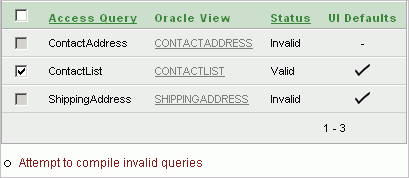
For each Microsoft Access query, the Queries page shows:
Oracle View - The corresponding Oracle view, which defaults to the Microsoft Access query name in all capital letters.
If the Microsoft Access object was not successfully migrated to Oracle, then this field will not have a corresponding Oracle view name. Instead, it will contain a link to a page where you can create a corresponding Oracle view.
Status - Query status as either Valid or Invalid.
Only valid queries can be included in the migration.
UI Defaults - Indicates if user interface defaults are set for the query.
User interface defaults are used by Oracle Application Express to populate initial values for region and item properties. Using user interface defaults provides consistency across multiple applications or across multiple pages in an application.
To run a bulk process that attempts to compile all invalid queries, click Attempt to compile invalid queries.
Using this option can validate some queries that show a status of invalid when initially migrated.
To create a view:
On the Queries page, click the link in the Oracle View column for the view you want to create.
The Object Browser opens.
Click the Create button.
From the list of object types, select View.
Follow the on-screen instructions.
To edit a query:
On the Queries page, click the Oracle view you want to edit.
Click Compile to find the invalid part of the query.
The Microsoft Access Query syntax appears in the edit window. It may require some modification to make it valid Oracle syntax.
Click Access Query to review the initial query and compare it to the converted query.
Click Edit.
Update the query and recompile it.
When it is validated, click the Queries breadcrumb.
To include this validated query, select it in the left column on the Queries page and click Apply Changes.
To set user interface defaults:
On the Queries page, click the Oracle view.
In the Tasks list on the right, click UI Defaults.
On the UI Defaults page, click Create Defaults.
The Table Defaults page appears, listing column information as it will appear in forms and reports. Note that you are now working in Application Builder, the component within Oracle Application Express where you build and modify applications.
To edit the information, click the Grid Edit button.
You can update the column label, change the sequence the columns will appear by default, and so on.
Click Apply Changes to save your updates.
To return to the Application Migration, click the Home breadcrumb. Then, select the Application Migrations link on the right, select your migration project, and click Queries.
To include queries in the migration, select them in the left column.
Click Apply Changes to save your selections.
Next, review the forms retrieved from the Microsoft Access export. Application Migration identifies invalid forms and lists additional information, such as the form's source type and source name.
For valid forms with a source type of table, you can select the type of object you want the form to become within Oracle Application Express: form (default), report and form, or tabular form.
Microsoft Access forms based on a query are migrated to Oracle Application Express forms. Microsoft Access forms based on a SQL query are migrated to Oracle Application Express reports.
After you update the forms, select the ones you want to include in the migration.
To review retrieved forms:
From the project page, click Forms.
The Forms page appears, showing the status of the objects ready for migration.

For each Microsoft Access form, the Forms page shows the following information, if available:
Source type:
Table
Query - The Oracle view that was migrated from the Microsoft Access query.
SQL Query - The original Microsoft Access SQL query that the Microsoft Access form is based on. Note that this query has not been parsed by the Oracle Migration Workbench. Therefore, you might must edit it to make it valid Oracle SQL syntax.
Nothing - The form has no underlying source type.
Source name - The Oracle table or view name if the source type is a table or query.
Status - Form status as Valid or Invalid. The source of the form must have a status of Valid before you can select it for migration.
A form's status is based on two factors: status of its underlying source object and inclusion of the source object in the migration. Specifically, a form has a status of valid if either one of these situations exists:
Its Source Type object (table, query, or SQL query) is valid, and it has been included in the migration. Its check box is enabled and can be selected.
Its Source type object has a status of valid, but the source object was not included in the migration. Its check box is disabled.
A form has a status of invalid if either one of these situations exists:
No Source Type is listed. Its check box is disabled.
Its Source Type object (table, query, or SQL query) is invalid. Its check box is disabled.
Startup form - Identifies the form that displays when you open your Microsoft Access database.
Parent form - Indicates the form/subform relationship that existed in your Microsoft Access database. For example, the CallListSub form shows Contacts as its Parent Form.
Migrate to: Form, Tabular Form, or Report and Form - The select list appears if the source type is a valid table.
To run a bulk process that attempts to compile all invalid SQL queries, click Attempt to compile invalid SQL queries.
Using this option can validate some SQL queries that show a status of invalid. Note that SQL queries from Microsoft Access forms are not loaded into the Oracle Migration Workbench, and are therefore not parsed.
To edit a SQL query:
On the Forms page, click the SQL Query you want to edit.
Click Validate to find the invalid part of the SQL query.
Click Edit.
Update the query and validate it.
When it is validated, click the project name breadcrumb.
To include the validated query, click Forms on the project page to go to the Forms page. Then select the newly validated query in the left column and click Apply Changes.
To edit a query:
On the Forms page, click Query for the form you want to edit.
Click Compile to find the invalid part of the query.
Click Access Query to review the initial query and compare it to the converted query.
Click Edit.
Update the query and recompile it.
When it is validated, click the Queries breadcrumb.
To include this validated query, select it in the left column on the Queries page and click Apply Changes.
To review details about a form, click the link in the Access Form column.
To include forms in the migration, select them in the left column.
Click Apply Changes to save your selections.
Next, review the reports retrieved from the Microsoft Access export. Application Migration identifies invalid reports and lists additional information, such as the report's source type and source name.
After you update the reports, select the ones you want to include in the migration. To include a report, the source of the report must have a status of Valid.
To review retrieved reports:
From the project page, click Reports.
The Reports page appears, showing the status of the objects ready for migration.
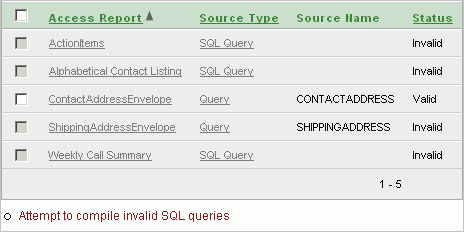
For each Microsoft Access report, the Reports page shows the following information, if available:
Source type:
Table
Query - The Oracle view that was migrated from the Microsoft Access query.
SQL Query - The original Microsoft Access SQL query that the Microsoft Access form is based on. Note that this query has not been parsed by the Oracle Migration Workbench. Therefore, you might must edit it to make it valid Oracle SQL syntax.
Nothing - The report has no underlying source type.
Source name
Status of the report: Valid or Invalid. The source of the report must have a status of Valid before you can select it for migration.
A report's status is based on two factors: status of its underlying source object and inclusion of the source object in the migration. Specifically, a report has a status of valid if either one of these situations exists:
Its Source Type object (table, query, or SQL query) is valid, and it has been included in the migration. Its check box is enabled and can be selected.
Its Source type object has a status of valid, but the source object was not included in the migration. Its check box is disabled.
A report has a status of invalid if either one of these situations exists:
No Source Type is listed. Its check box is disabled.
Its Source Type object (table, query, or SQL query) is invalid. Its check box is disabled.
To run a bulk process that attempts to compile all invalid SQL queries, click Attempt to compile invalid SQL queries.
Using this option can validate some SQL queries that show a status of invalid. Note that SQL queries from Microsoft Access forms are not loaded into the Oracle Migration Workbench and are therefore not parsed.
To edit a SQL query:
On the Reports page, click the SQL Query link you want to edit.
Click Validate to find the invalid part of the SQL query.
Click Edit.
Update the query and validate it.
When it is validated, click the project name breadcrumb.
To include the validated query, click Reports on the project page to go to the Reports page. Then select the newly validated SQL query in the left column and click Apply Changes.
To edit a query:
On the Reports page, click Query for the report you want to edit.
Click Compile to find the invalid part of the query.
Click Access Query to review the initial query and compare it to the converted query.
Click Edit.
Update the query and recompile it.
When it is validated, click the Queries breadcrumb.
To include this validated query, select it in the left column on the Queries page and click Apply Changes.
To review details about a report, click the link in the Access Report column.
To include reports in the migration, select them in the left column.
Click Apply Changes to save your selections.
From the project page, you can drill down to see information about the database, modules, and pages for the migration project.
Database - Displays summary information about the Microsoft Access database, including the full path and size of the .mdb file.
Modules - Displays the Visual Basic Code, enabling you to extract embedded SQL statements for you to use or edit in your Oracle Application Express application.
Pages - Displays information for reference purposes.
After validating and updating objects, you now need to generate the application in Oracle Application Express. You can create an application based on valid forms and reports, or a maintenance application based on valid tables and views.
When creating an application, a home page is defined by default. You have the option to create additional blank pages so that you can introduce further navigation possibilities.
You can then choose which user interface theme your application should be based on. By default, the application uses one level of tabs.
As a shortcut, you can also set some application defaults. These defaults are used whenever you create new applications.
Setting Up Application Defaults
To set up application defaults (optional):
On the right side of the project page, click Generate Application Defaults in the Tasks list.
Select the options you want to use as defaults.
For information, click Help or click the item label. Clicking the item label opens a separate window describing the item and its options.
Click Apply Changes.
The project page appears.
To generate either type of application:
On the right side of the project page, click one of the following in the Tasks list:
Generate Application - This option generates an application based on the forms and reports you selected to include.
Generate Maintenance Application - This option generates an application based on the tables and queries you selected to include.
In the Selected Application Objects section, you can customize specific pages.
For example:
To rename a page, click the page link and enter the new name on the New Page Definition page that appears.
To select the type of navigation on the application's home page, click the Home Page link.
On the New Page Definition page that appears, select Vertical Unordered List with Bullets, Vertical Images List or Horizontal Images List for Navigation.
To display an image on a parent page, click the page link.
On the New Page Definition page that appears, go to the Page Icon field and select the image you want to appear on that page. You can either select an image from the select list or click the Find icon (flashlight) to open a page of options.
Repeat this step for each parent page. If you do not explicitly select an image for a page, the default image appears for that page.
Note that for the image to appear in your application, you must have selected either Vertical Images List or Horizontal Images List for the Home page navigation.
To add a blank page to the application, scroll down to the Add Page section and click Add Page.
Note that the new page appears at the bottom of the list in the Selected Application Objects section.
Click Next to select a theme for the application, or click Create to skip the theme selection step.
If you skip the theme step, the default is used.
Select a theme for the application and click Next.
A theme is a collection of templates that define the layout and style of an application, including buttons and pages.
Confirm your selections and click Create.
To preview the application, click Run Application.
Log in using your Oracle Application Express workspace credentials.
Your application now appears as a separate application in Oracle Application Express.
To customize your application, scroll down to the Developer toolbar and click Edit Application.
You might want to do the following customizations immediately after you generate your application:
Rename the application. Each application has a unique ID, but the migration project name becomes the application name by default. To more easily identify an application, you might want to change its name to something more meaningful by editing the application attributes.
Change the authentication scheme. By default, the authentication scheme is Application Express authentication. You can change this by editing the application attributes.
See Also:
For instructions on editing application attributes, adding pages, deploying your application, and so on, see Oracle Application Express Application Builder User's Guide or the Oracle Application Express online Help.When you delete a migration project, you delete only the metadata associated with the migration project. Deleting a migration project does not delete or impact applications you have generated from the project or any objects, such as tables or views, in the schemas associated with your workspaces.
To delete a migration project:
Log in to Oracle Application Express.
Under Migrations on the right side of the Workspace home page, click the Application Migrations link.
On the Application Migrations page, click the project you want to delete.
On the project page, click Delete Project from the Tasks list on the right.
Click the Delete Project button and confirm the deletion.